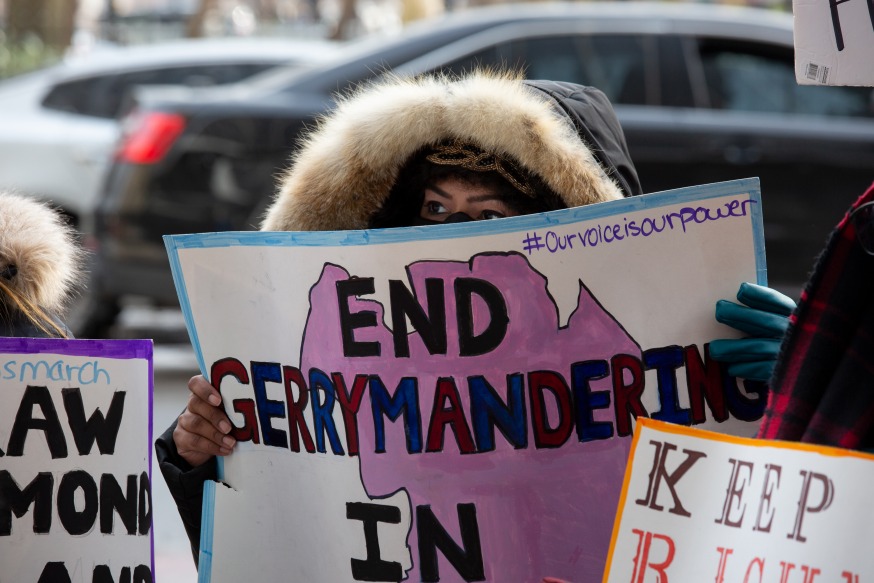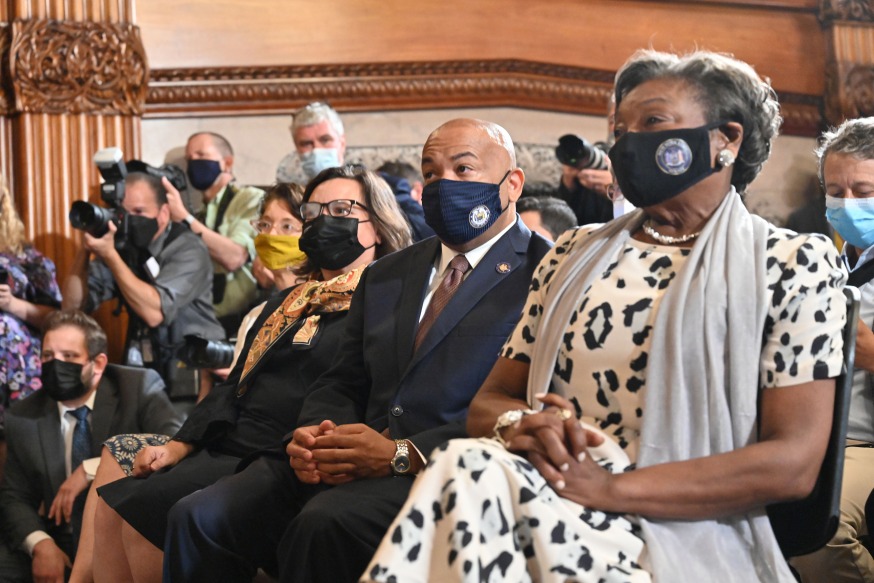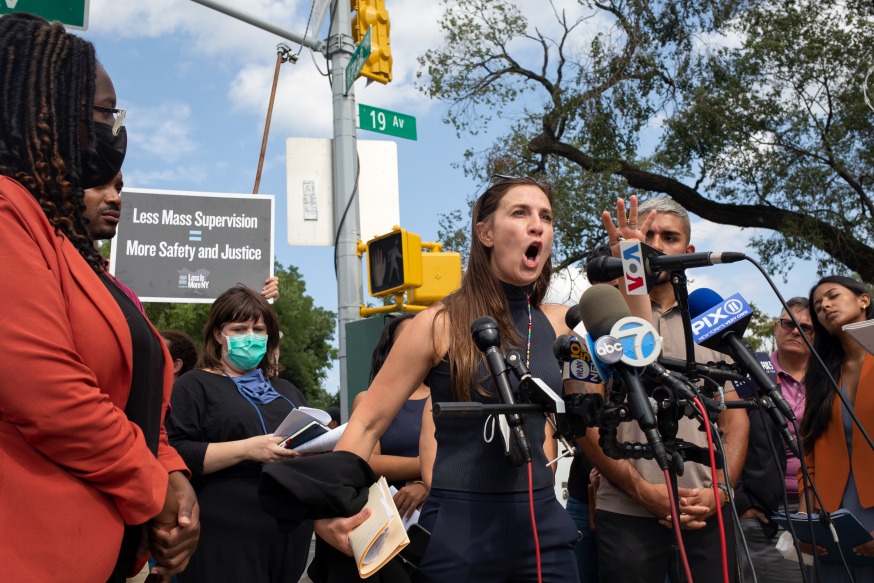
A voting-rights activist protested near City Hall about proposed redistricting in Queens, Jan. 31, 2022. | Ben Fractenberg/THE CITY

This article was originally published by The CITY on April 22
When Albany’s “independent” commission failed to come up with legislative maps everyone could agree on earlier this year, Democrats controlling the Capitol took matters into their own hands. Republicans cried foul and two courts have partially agreed with them.
Who’s going to be your next representative in Albany or Washington? It depends what district you live in — and that remains to be seen.
Ahead of November’s general election, New Yorkers are supposed to vote in party primaries on June 28. Because the city is so blue, few seats, either at the federal or state level, are genuinely up for grabs in the fall. The primary is when most electoral choices really get made.
But the process is now partially in limbo, thanks to two court decisions since late March that have rejected the political district lines, collectively known as maps, state lawmakers had approved earlier this year.
Those maps had already factored into some big political decisions.
For example, State Sen. Alessandra Biaggi had already launched a campaign for a newly drawn congressional seat that combined parts of her district in The Bronx and Westchester with Queens and Long Island. In Brooklyn and Staten Island, former Congress member Max Rose is running again for his old seat, which has been redrawn to include super-liberal Park Slope.
The first court decision in March had tossed out all the maps, but the appellate division reinstated all but the Congressional district lines in an April 21 decision.
What now? There are a lot of variables. So, we talked to election law experts to sort out what New Yorkers should know about the redistricting chaos right now.
What happened to the political maps, and what’s next?
The maps at issue here were approved by the Democrat-controlled state legislature and Gov. Kathy Hochul on Feb. 3. Soon after, voters backed by state Republicans sued, claiming the maps were gerrymandered and, therefore, unconstitutional.
On March 31, State Supreme Court Justice Patrick McAllister in upstate Steuben County ruled in the GOP’s favor, saying that the map challengers had proven “beyond a reasonable doubt that the map was enacted with political bias.” (Reminder: in New York, the “Supreme Court” is the lowest legal tier for judges; the Court of Appeals is the highest.)
He ordered the legislature to draw up new maps by April 11.
But the State Senate and Assembly immediately appealed, triggering an automatic stay, or pause, of the judge’s decision.
Then on April 21, a panel of judges in the Appellate Division ruled in favor of the lower court’s decision when it comes to Congressional districts, but reversed the lower court’s decision on the state-level districts.
The judges wrote in the opinion that state Democrats “failed to meet the high burden of proving beyond a reasonable doubt that the legislature drew the 2022 congressional district map in a manner ‘to discourage competition or or the purpose of favoring or disfavoring incumbents or other particular candidates or political parties,’” citing the state constitution.
So, federal districts are now up in the air, but State Senate and Assembly districts are OK, according to the court.
The latest ruling ordered the state legislature to draw a new map of Congressional districts by April 30.
The Court of Appeals has already said it will hear the case on Tuesday, April 26. Its decision will trump that of the two lower courts.
As the case goes forward, the state’s current political calendar has set May 4 as its deadline to certify the June 28 primary ballot.
Remind me: How did we get these maps in the first place?
Lawmakers in Albany had created new political boundaries for State Senate and Assembly districts, as well as Congressional seats, based on 2020 population figures from the U.S. Census Bureau. The process happens every 10 years in each of the 50 states.
This time, in New York, the process was supposed to be more fair, independent and less partisan. That was the goal, anyway, of a 2014 state constitutional amendment that created an Independent Redistricting Commission charged with creating maps in a bipartisan way.

Assembly Speaker Carl Heastie and Senate Majority Leader Andrea Stewart-Cousins watch as Kathy Hochul is sworn in as governor, August 24, 2021. Kevin P. Coughlin/Office of the Governor
But the IRC published dueling maps split along partisan lines, then failed to come up with another set before the deadline set by the state constitution.
Eventually, the map-mapping fell back to the legislature after the ostensibly “independent” commission failed.
In early 2022, both state legislative houses created the maps we have today, and Governor Kathy Hochul signed them.
Aren’t candidates already running for the June primary? What happens to them?
Yes, lots of would-be candidates are in the middle of prepping to run for office in the same political boundaries that are being fought over in court.
In their decision, the Appellate Division judges made no mention of the June primary, or if it should change to allow more time for candidates and voters to prepare for the election. Courts weighing in on redistricting cases in other states have ordered new primary dates, most recently in Maryland.

Sen. Alessandra Biaggi is running for Congress in a district that is in limbo. Sept. 13, 2021. Ben Fractenberg/THE CITY
For weeks, candidates have been petitioning to get on the ballot, a tedious process of gathering hundreds of signatures from voters, then submitting them to the state Board of Elections for approval.
According to the BOE’s political calendar, candidates had to submit those petition signatures between Monday, April 4 and Thursday, April 7.
Through the court battles, elections lawyer Sarah Steiner has advised her candidate clients to keep carrying on and submit their signatures.
What’s the most likely outcome for the maps?
The experts we spoke with said the most probable scenario is that New York’s highest court will reverse the earlier rulings, and the legislature’s maps will remain.
Jeff Wice, a New York Law School professor and veteran of two previous redistricting processes in New York, said the precedent of the state’s highest court, the Court of Appeals, is that they have “always deferred to the legislature and its judgment” on redistricting matters.
Attorney Jerry Goldfeder, also an election law vet, said the timing of the case doesn’t allow much room for changes before the June primary.
“The United States Supreme Court has repeatedly ruled that changes to election laws shouldn’t be done on the eve of an election,” he said.
Steiner emphasized that, if the courts mandate a map change, it would throw the election calendar into chaos — and any changes to the primary date, or process of getting on the ballot would have to come from the legislature, not the courts.
“Do you really see the legislature, all of whom have just gone through petitioning with its volunteer cost and time cost and money cost … Do you really see them saying, ‘Oh, sure. Let’s do it again’?”’ she asked.
OK, but what if the maps do get thrown out?
The possibility remains that the higher courts — either the Appellate Department, or the Court of Appeals — sides with the Steuben County judge. From there, any number of things could happen, including that the court orders the legislature back to the drawing board.
If that comes to pass, political boundaries would change again and the many candidates who have flooded into races since the new maps emerged — or bowed out — would need to reconsider.
Don’t see the graphic? Click here.
How the maps are drawn have national implications and New York’s federal district lines could have a big impact on whether Democrats keep control of the House of Representatives.
There is also the possibility that a third party, not the legislature, could be brought in by the courts to create new political lines.
So, what is a voter — or would-be candidate — to do?
Stay patient, experts say.
Candidates should campaign as usual. And all voters can do is wait and see because “we just don’t know,” Wice said.
“It’s best to take this one day, and one step, at a time,” he said.
It might not hurt to read up on some candidates running in districts adjacent to yours, just in case.
Goldfeder hoped it would be resolved sooner rather than later — before voters become even less engaged.
“The unintended consequence here is that voters become more disenchanted at the politics involved and not knowing who their representatives are going to be,” he said. “So, this really needs to be decided very quickly.”
THE CITY is an independent, nonprofit news outlet dedicated to hard-hitting reporting that serves the people of New York.
